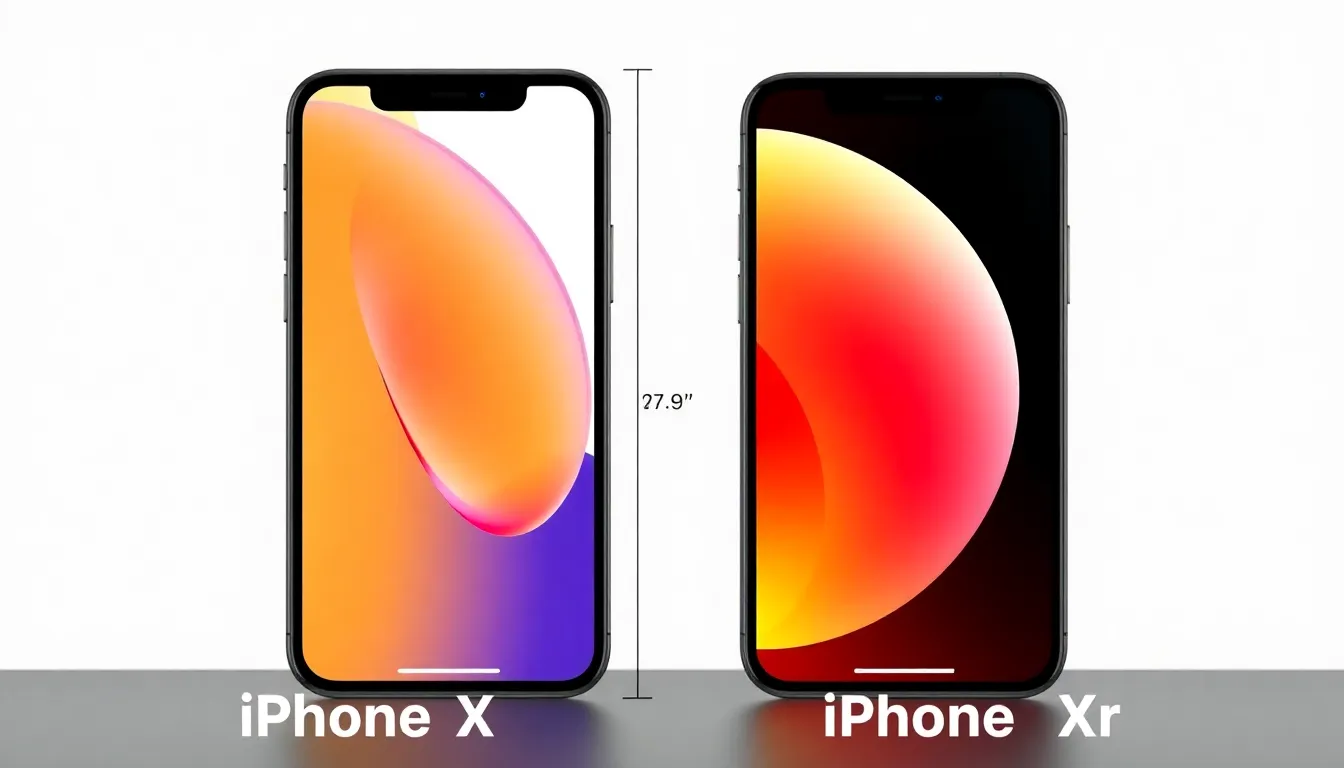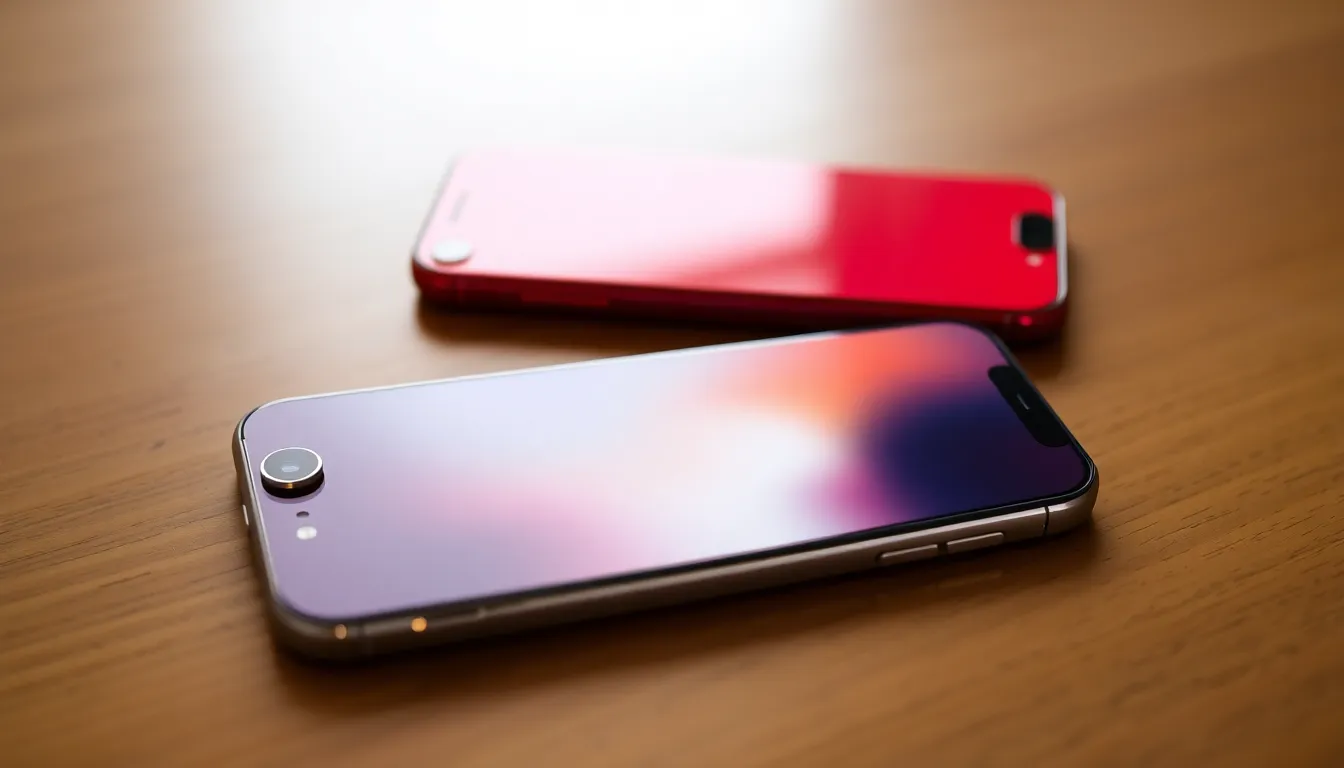Table of Contents
ToggleWhen it comes to choosing a smartphone, size definitely matters—especially if you’re trying to impress your friends or fit it comfortably in your pocket. The iPhone XR and iPhone X are two popular contenders, but the burning question remains: is the iPhone XR bigger than the X?
Overview of iPhone XR and iPhone X
iPhone XR and iPhone X belong to Apple’s smartphone lineup but differ in several key aspects. The dimensions of the iPhone XR measure 150.9 x 75.7 x 8.3 mm, while the iPhone X has smaller dimensions at 143.6 x 70.9 x 7.7 mm. Users often appreciate the larger display of the iPhone XR, which boasts a 6.1-inch screen compared to the 5.8-inch screen on the iPhone X.
Both models feature a Super Retina display, yet their resolutions vary. The iPhone XR offers a resolution of 1792 x 828 pixels, whereas the iPhone X presents a resolution of 2436 x 1125 pixels. This results in sharper images on the iPhone X, appealing to those who prioritize display quality.
Weight also plays a role in user experience. The iPhone XR weighs 194 grams, making it slightly heavier than the iPhone X, which weighs 174 grams. Heftier devices can feel more substantial in hand.
Both smartphones include Face ID, but their design aesthetics vary. The iPhone X has a glass back and stainless steel frame, while the iPhone XR uses aluminum and glass. Color options complement the design differences, with the iPhone XR available in multiple vibrant colors, contrasting the more subdued options of the iPhone X.
Battery life represents another significant difference. The iPhone XR features a larger battery capacity, providing up to 25 hours of talk time compared to the iPhone X’s 21 hours. This aspect can strongly influence user choices based on usage patterns.
Physical Dimensions Comparison

The iPhone XR and iPhone X differ significantly in their physical dimensions. These variations affect user experience and preferences regarding smartphone size.
Height and Width
Height comparisons reveal that the iPhone XR stands at 150.9 mm, while the iPhone X measures 143.6 mm. Width-wise, the iPhone XR spans 75.7 mm, compared to 70.9 mm for the iPhone X. Users often favor the larger dimensions of the iPhone XR for its spacious display. The increase in height and width allows for enhanced visibility of content. Consequently, users looking for a larger screen may lean towards the iPhone XR.
Thickness and Weight
Thickness figures show that the iPhone XR is 8.3 mm thick, while the iPhone X is slimmer at 7.7 mm. The difference in design affects how each phone feels in the hand. Weight plays a crucial role as well, with the iPhone XR weighing 194 grams versus 174 grams for the iPhone X. The added weight of the iPhone XR may suggest sturdiness, but some users prefer the lighter feel of the iPhone X. Choices between these two models often depend on personal preferences regarding thickness and weight.
Display Features
The display features of the iPhone XR and iPhone X play a crucial role in how users experience these devices. Comparing their screen specifications reveals notable differences.
Screen Size and Resolution
The iPhone XR sports a larger 6.1-inch display. In contrast, the iPhone X has a 5.8-inch screen. This size difference enhances visibility for tasks like browsing or watching videos. Users might favor the iPhone XR for its expansive viewing area. Resolution varies significantly between the two models. The iPhone XR has a resolution of 1792 x 828 pixels. The iPhone X surpasses this with a higher resolution of 2436 x 1125 pixels. Consequently, users who prioritize clarity may prefer the iPhone X for its sharper visuals.
Display Technology
Both models utilize Apple’s Super Retina display technology. While they share this aspect, differences in performance arise. The iPhone X offers superior contrast ratios and deeper blacks. These features are due to its OLED panel. The iPhone XR, however, employs an LCD panel, resulting in slightly less vivid colors. Despite its lower resolution, the iPhone XR still provides an enjoyable viewing experience. Users may find the display quality adequate for everyday tasks. Overall, the display technology influences user choices directly, catering to specific preferences for quality and performance.
Design and Aesthetics
The design and aesthetics of the iPhone XR and iPhone X reflect their unique identities. Both models showcase Apple’s premium craftsmanship but differ in color options and build materials.
Colors and Finishes
The iPhone XR stands out with a vibrant palette of colors, including red, yellow, blue, coral, black, and white. Bright shades appeal to users wanting a personalized device. In contrast, the iPhone X offers a more classic look with only silver and space gray. Subtle hues attract those who prefer elegance over vibrancy. The various options allow users to express their personal style, highlighting the XR’s playful aesthetic against the X’s sophisticated design.
Build Quality
Build quality varies notably between the two models. Aluminum and glass constructions characterize the iPhone XR, promoting durability while maintaining a lighter feel. The iPhone X features a more premium stainless steel frame, enhancing its overall rigidity and giving it a more luxurious touch. Users often appreciate the stability of the X, while the XR’s lighter weight can be an advantage for long-term handling. Each option caters to different preferences, emphasizing either robustness or comfort.
User Experience
User experience revolves around how individuals interact with their devices daily. The differences between the iPhone XR and iPhone X significantly impact user satisfaction.
Handling and Comfort
Handling both smartphones reveals distinct experiences. The iPhone XR’s dimensions, at 150.9 x 75.7 x 8.3 mm and 194 grams, lend it a larger, sturdier feel. Many users appreciate the grip offered by its size. In contrast, the iPhone X, measuring 143.6 x 70.9 x 7.7 mm and weighing 174 grams, provides a lighter option that users find easier to maneuver. Users often highlight how this lighter weight enhances portability. Thickness also influences comfort; the iPhone XR’s extra millimeter contributes to a more substantial presence, while the slimmer iPhone X caters to those preferring sleek designs.
Performance in Daily Use
Daily performance showcases vital differences tied to display technology. Individuals using the iPhone XR enjoy a 6.1-inch Liquid Retina display, which significantly enhances visibility for browsing and streaming. Many appreciate this larger screen while engaging in media-related tasks. The iPhone X, however, features a 5.8-inch Super Retina OLED display, delivering sharper resolution at 2436 x 1125 pixels. Users keen on visual quality often favor this vivid display for its contrast and depth. Battery life further influences user engagement; the iPhone XR’s 25 hours of talk time allows for extended use, making it favorable for users who rely heavily on their device throughout the day.
The comparison between the iPhone XR and iPhone X highlights the distinct preferences users have when it comes to smartphone size and features. The iPhone XR’s larger dimensions and vibrant color options cater to those seeking a more spacious and personalized device. Meanwhile the iPhone X appeals to users who prioritize a premium design and superior display quality.
Ultimately the choice between these two models depends on individual needs regarding display size battery life and overall feel. Whether one prefers the sturdiness of the iPhone XR or the elegance of the iPhone X it’s clear that both devices offer unique advantages to their users.




